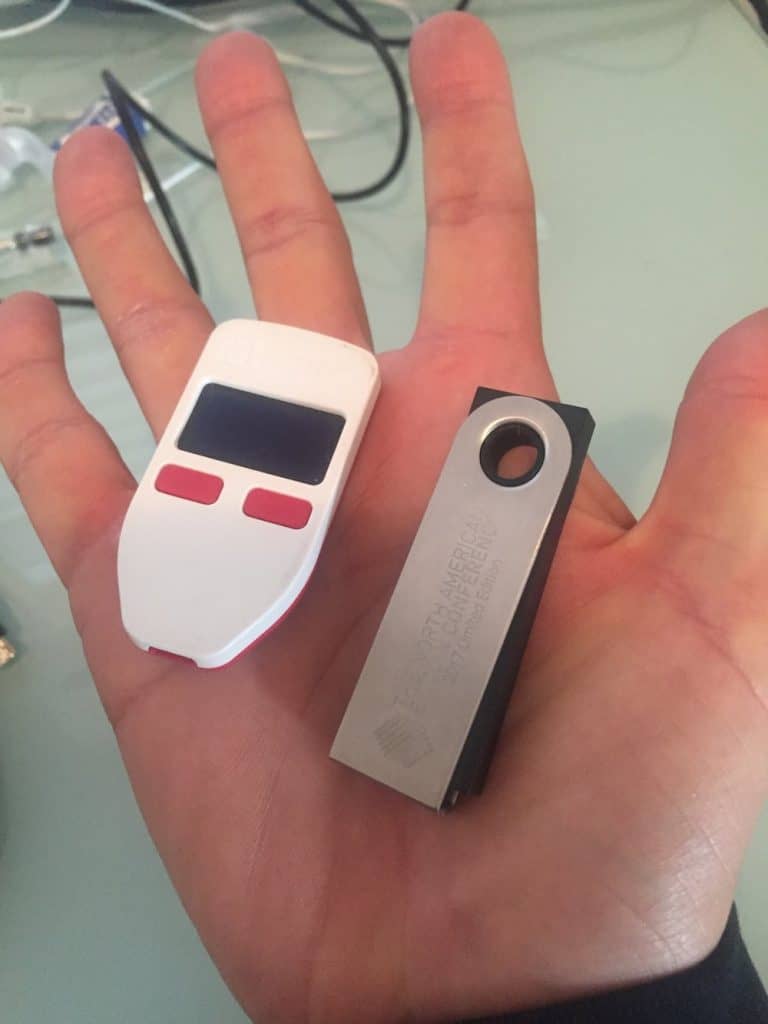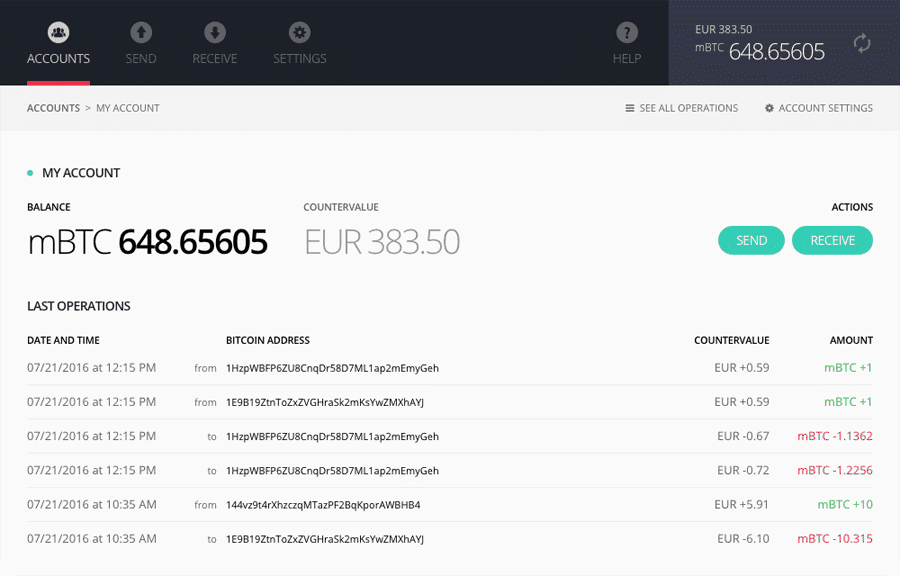Recently I attended the North American Bitcoin Conference in Miami. Ledger, one of the leading hardware wallets manufacturers were selling their merchandise at the event and I decided to finally do my Ledger Nano S review which I have postponed far too long.
So I bought myself a specially engraved Ledger Nano S created just for the conference and today I’m testing it out for the first time. If you’ve been an avid reader of 99Bitcoins you probably know I’m a long time fan of TREZOR, Ledger’s main competitor. But I’ve been hearing so many good things about the Ledger Nano that I decided to do a TREZOR vs Ledger type of comparison.

Before I begin my review a quick word about Bitcoin hardware wallets. Hardware wallets are probably the most robust form of security you can have for your Bitcoins or any other cryptocurrency. They allow you to send and receive Bitcoins on any computer, even one that is compromised with malware, with the knowledge that your transaction will still go through as intended. For more information about Bitcoin wallets in general watch out latest Bitcoin Whiteboard Tuesday episode.
The way the hardware wallets achieve maximum security is by storing your private key and signing your Bitcoin transactions offline so someone trying to “hack” your wallet remotely won’t be able to do so. Most hardware wallets also use a second screen / device to verify actions on your wallet such as signing transaction. This way, if a hacker gain control over your computer, he still can’t do any harm since he requires access to the physical device connected to your computer as well.
I’ve reviewed the former Ledger model, the Ledger Nano in the past. Back then I concluded that the added protection that a TREZOR wallet gives you with it’s second screen protection is superior to the Ledger Nano. However the Ledger Nano S now features a second screen feature as well. So this comparison is going to be interesting.
Design and user interface
Design-wise the products are pretty much the same. Both are small and compact, however the Ledger Nano S does have a slight advantage in the sense that its metal casing makes it more durable in my opinion (and also a bit sexier). Both wallets will both fit pretty easily into your pocket or hand as can be seen below.

The way the Ledger Nano S works is pretty similar to any hardware wallet. When you first set it up you will choose a PIN to protect the device from unwanted access. Later, you will receive a 24 word seed that will be used to create your private keys (this is what’s known as an HD wallet, more on that here). This seed should be written down in a safe place and NOT on your computer, as whoever knows this seed has control over your Bitcoins. A good suggestion would be to write this seed down using a Cryptosteel device.
The Ledger Nano S has two buttons that allow you to control it. The initial set up of the device is pretty simple and takes about 3 minutes. Most of the time is spent on writing down your seed.
This seed creation is one of the places where the second screen comes into play. If your computer is compromised a hacker will be able to see the seed if it’s displayed on your screen. This is exactly why the seed words are shown on the small device screen that is tamper-proof, so you know that only you see your seed.
Once the device is set up, all that’s left is to install an app that allows you to interface with the device (i.e. send and receive Bitcoins).

The app I used is a Chrome application that gives you the following functionalities:
- General account details
- Sending Bitcoins from your hardware wallet
- Generating your Bitcoin address to receive Bitcoins
- Settings for your app (e.g. exchange rate, language, etc.)
The app is pretty similar to the one TREZOR uses although it has a sleeker design.

The interface (as shown above) is pretty intuitive and doesn’t require any manual to get the hang of it. Also, unlike TREZOR’s interface, you can rename accounts and don’t have to call them in general names like “account #1”. It may sound stupid but this is a big advantage in my opinion, especially when you want to divide your funds into several sub accounts.
The Ledger Nano S can also use existing Bitcoin wallets instead of the current chrome app interface. Such wallets include MyCellium, Electrum, Bitgo, GreenBits, Copay and MyEtherWallet.
Here’s a complete review of how the device works done by BTC Sessions on YouTube:
Support of altcoins
The Ledger Nano S includes Bitcoin, Litecoin, Ethereum and Ethereum Classic companion apps, and other blockchain-based cryptocurrencies. You can send and receive payments, check your accounts and manage multiple addresses for each currency from the same device.
TREZOR on the other hand recently announced that they have partnered with MyEtherWallet to support Ethereum on their device as well. However no other currencies are supported through TREZOR at the moment.
Company reputation
Ledger was founded in 2015 in France. The company has since gained substantial traction in the Bitcoin and cryptocurrency sphere and has grown to be a worthy competitor to SatoshiLabs (the creators of TREZOR). TREZOR on the other hand has been in the market since 2014.
Both Ledger and TREZOR use open source code for their apps, and both have demonstrated excellent customer support and stability in the past few years. Even though TREZOR is the more mature and respected company, it’s hard to say the Ledger falls behind.
Price tag
The Ledger Nano S sells for €58 (about $65) while the TREZOR sells for $99. This makes the Nano S a more attractive bargain since their features are almost identical. One can argue that the TREZOR can also act as a password manager but I’m not sure how useful this feature is at the moment.
So who’s the winner?
In all honesty, I think the Ledger Nano S wins due to the lower price. But both companies created a great product. The Ledger Nano S seems to have the upper hand in design and usability, while TREZOR’s reputation has more impact in the community (although not by much). Since most of us are price sensitive in this case the price tag tips the scale towards Ledger.
Personally, I use a TREZOR, mainly because when I first started using hardware wallets Ledger wasn’t around yet. Today I think I may start using both, storing some of my funds on a TREZOR and some on a Ledger. I have to say that the progress Ledger has made in the past year is truly impressive, and there product shows it.
‘);
$.post(url, {
‘action’: ‘olovei_bbw’,
‘country’: $(‘#obbww6420 select[name=country]’).val(),
‘payment’: $(‘#obbww6420 select[name=payment]’).val(),
‘limit’: ‘5’,
‘id’: ‘obbww6420’
}, function(response) {
$(‘#obbww6420’).hide();
$(‘#obbww6420-result’).html(response);
});
return false;
});
$(document).on(‘click’, ‘button.obbww6420-search-again’, function() {
$(‘#obbww6420-result’).html(”);
$(‘#obbww6420’).show();
});
$.get(‘/wp-content/plugins/olovei-buybitcoinworldwide/location.php’, function(response) {
if (response) {
$(‘#obbww6420 select[name=country]’).val(response);
}
});
})(jQuery);

TheBitcoinNews.com – Bitcoin News source since June 2011 –
Virtual currency is not legal tender, is not backed by the government, and accounts and value balances are not subject to consumer protections. TheBitcoinNews.com holds several Cryptocurrencies, and this information does NOT constitute investment advice or an offer to invest.
Everything on this website can be seen as Advertisment and most comes from Press Releases, TheBitcoinNews.com is is not responsible for any of the content of or from external sites and feeds. Sponsored posts are always flagged as this, guest posts, guest articles and PRs are most time but NOT always flagged as this. Expert opinions and Price predictions are not supported by us and comes up from 3th part websites.
Advertise with us : Advertise
Our Social Networks: Facebook Instagram Pinterest Reddit Telegram Twitter Youtube











